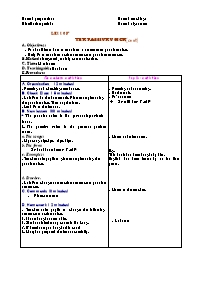Giáo án English 10 - Lesson: The passive voice (cont)

A. Objectives:
- Ps should learn how to transform a statement to passive voice.
- Help Ps to transform active sentences to passive sentences.
B. Method: Integrated, mainly communicative.
C. Time: 45 minutes
D. Teaching aids: Handouts
E. Procedure:
Bạn đang xem tài liệu "Giáo án English 10 - Lesson: The passive voice (cont)", để tải tài liệu gốc về máy bạn click vào nút DOWNLOAD ở trên
Date of preparation: Date of teaching: Distributive period: Date of signature: Lesson The passive voice (cont) A. Objectives: - Ps should learn how to transform a statement to passive voice. - Help Ps to transform active sentences to passive sentences. B. Method: Integrated, mainly communicative. C. Time: 45 minutes D. Teaching aids: Handouts E. Procedure: Teacher’s activities Pupils’ activities A. Organization. ( 2 minutes) - Greeting and checking attendance. B. Check – up: ( 5 minutes) - Ask Ps to do the homework. Give examples using the passive voice. Then say the form. - Lead Ps to the lesson. B. New lesson (33 minutes) * The passive voice in the present perfect tense. 1. The passive voice in the present perfect tense. a. The usage: - Mét c«ng viÖc ®îc thùc hiÖn. b. The form: S + has / have been + V-edP2 c. Examples: - Teacher asks pupils to give examples using the passive voice. d. Practice. - Ask Ps to change some active sentences to passive sentences. C. Comments (3 minutes) Give comments D. Homework ( 2 minutes) - Teacher asks pupils to change the following sentences to active voice. 1. I have bought a new shirt. 2. She has visited many caves in Ha Long. 3. Where have you bought this coat? 4. Mary has prepared the lesson carefully. - Greeting and answering. - Do the task. - Ps’ answer: à S + will be + V-edP2 - Listen and take notes. E.g. This book has been bought by him. English has been learnt by us for five years. - Listen to the teacher. - At home
Tài liệu đính kèm:
 Unit_8_The_story_of_my_village.doc
Unit_8_The_story_of_my_village.doc





